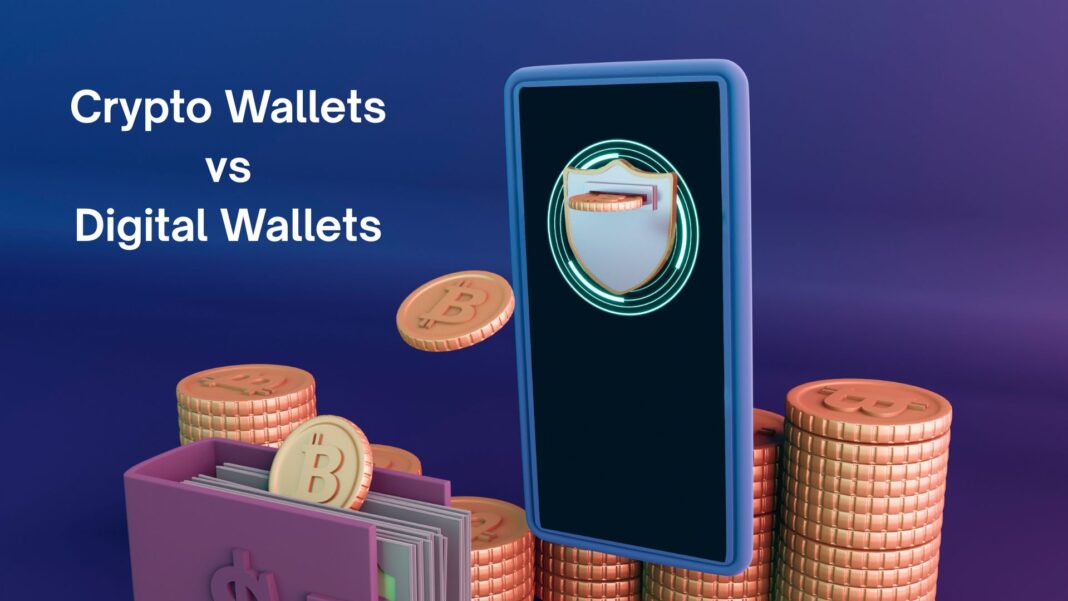Digital finance offers many tools for managing funds. We use various digital wallets for transactions. However, understanding their core function is vital. Crypto wallets handle decentralized digital assets. Traditional digital wallets manage conventional currency. Their underlying systems and how they secure your money differ fundamentally. This distinction profoundly impacts how you manage your digital wealth.
The Core Difference: What They Store and How They Work
The most crucial difference lies in the type of asset they manage and how they interact with the underlying financial system.
Cryptocurrency Wallets:
- What they store: They do not store actual cryptocurrency. Instead, they store private keys (like a super-secure password) and public keys (like a bank account number). These keys allow you to access and control your specific cryptocurrencies (Bitcoin, Ethereum, etc.). Your crypto always lives directly on its respective blockchain.
- Underlying System: They operate on decentralized blockchain networks. No single bank, company, or government controls these networks. This means transactions are peer-to-peer (P2P), often without intermediaries (in a non-custodial wallet).
- Control/Ownership: In non-custodial crypto wallets, you have sole control over your private keys. This gives you true ownership of your digital assets. If you lose your keys, you lose access to your crypto – there’s no “forgot password” option in the crypto world.
- Regulation: The cryptocurrency space is largely unregulated by traditional financial authorities in many parts of the world, or regulations are still evolving. In this region, for instance, crypto is currently legal but subject to a 30% tax on gains and 1% TDS on transactions. Exchanges register with the Financial Intelligence Unit (FIU), but crypto wallets themselves are not regulated like traditional wallets.
- Use Case: Primarily for investing, trading, and interacting with decentralized applications (dApps), DeFi (decentralized finance), and NFTs (Non-Fungible Tokens). They are not designed for everyday fiat currency transactions.
- Security: Relies on cryptographic security (public/private key pairs). You are primarily responsible for your own security (backing up keys, using hardware wallets).
Google Pay/PhonePe Wallets & Normal Banking Wallets (e.g., PayTm using UPI):
- What they store: These wallets store fiat currency (like Rupees). They are essentially a digital representation of money held by a centralized entity.
- Wallet Balance (e.g., Paytm Wallet, PhonePe Wallet): You pre-load money into these wallets. The wallet provider (e.g., Paytm, PhonePe) holds that money in their bank account. You then use their app to spend from this pre-loaded balance. These are often “semi-closed” wallets.
- UPI-linked (e.g., Google Pay, PhonePe, Paytm using UPI): These apps don’t store your money. They act as an interface to directly connect to your bank account via the Unified Payments Interface (UPI) system. When you pay, money moves directly from your bank account to the recipient’s bank account. They manage your bank account information and payment credentials (like UPI PIN).
- Underlying System: They operate on centralized financial systems. Banks, payment processors, and regulatory bodies (like the central bank and national payments corporation) control these systems.
- Control/Ownership: You don’t directly “own” the digital money in the same way you own crypto keys. You have a claim to the money held by the wallet provider or your bank. The bank or wallet provider controls access to your funds. They offer customer support, fraud protection, and recourse options.
- Regulation: These wallets and payment systems are highly regulated by central banks and financial authorities. They require KYC (Know Your Customer) and AML (Anti-Money Laundering) compliance.
- Use Case: Primarily for everyday transactions with fiat currency: bill payments, mobile recharges, online shopping, P2P transfers, paying merchants, and ATM withdrawals (for some types like open wallets).
- Security: Relies on traditional banking security measures: passwords, PINs, OTPs, 2FA, biometric authentication, and the bank’s fraud detection systems. Funds are often insured by government entities (e.g., deposit insurance up to a certain limit for bank deposits).
Key Differences Summarized
| Feature | Cryptocurrency Wallets | Paytm/PhonePe Wallets & Bank Wallets (UPI) |
| What they hold | Private keys that control access to crypto on a blockchain | Fiat currency (INR) balances or link directly to bank accounts |
| Asset Type | Cryptocurrencies (Bitcoin, Ethereum, etc.) | Fiat currency (Rupees) |
| Underlying System | Decentralized Blockchain Networks | Centralized Banking & Payment Systems (e.g., UPI) |
| Ownership/Control | You hold private keys (non-custodial) or a 3rd party holds (custodial) | Bank/Wallet Provider holds funds; you have a claim |
| Regulation | Limited or Evolving; often self-regulated; exchange registration with FIU | Highly Regulated by Central Bank & National Payment Corporation |
| Primary Use | Investing, trading, DeFi, NFTs | Everyday payments, bill pay, shopping, P2P transfers |
| Security Type | Cryptographic (keys), user responsibility for self-custody | Banking-grade security, fraud detection, insurance |
| Intermediaries | No intermediaries (for non-custodial wallets) | Banks, payment networks, wallet providers are intermediaries |
| Reversibility | Transactions are generally irreversible | Transactions can sometimes be reversed with bank intervention (e.g., fraud) |
In essence, a cryptocurrency wallet is your personal gateway to the decentralized world of blockchain and digital assets. It gives you direct control but also full responsibility. Paytm, PhonePe, and traditional bank wallets are digital conveniences for spending and managing your conventional money. They operate within the regulated banking system, where intermediaries provide ease of use and a safety net.




